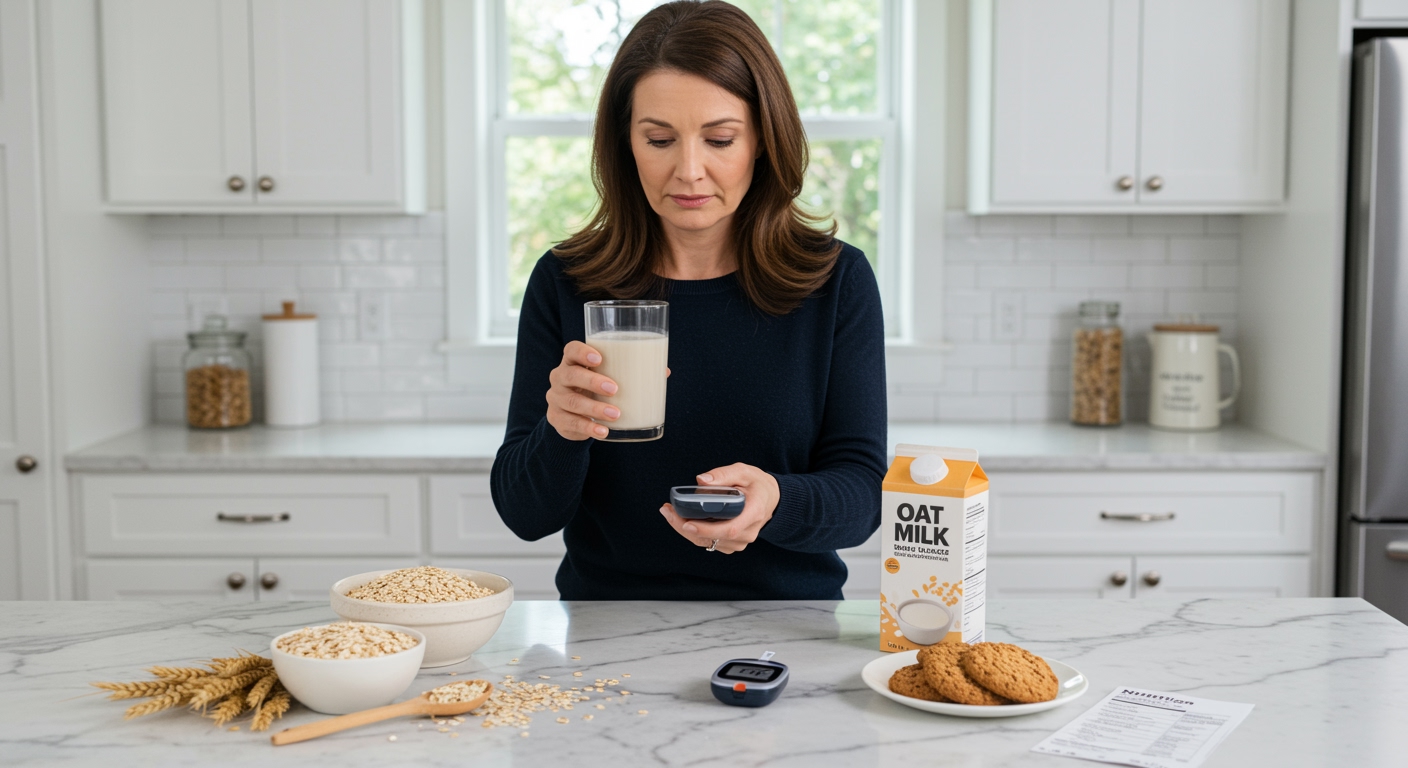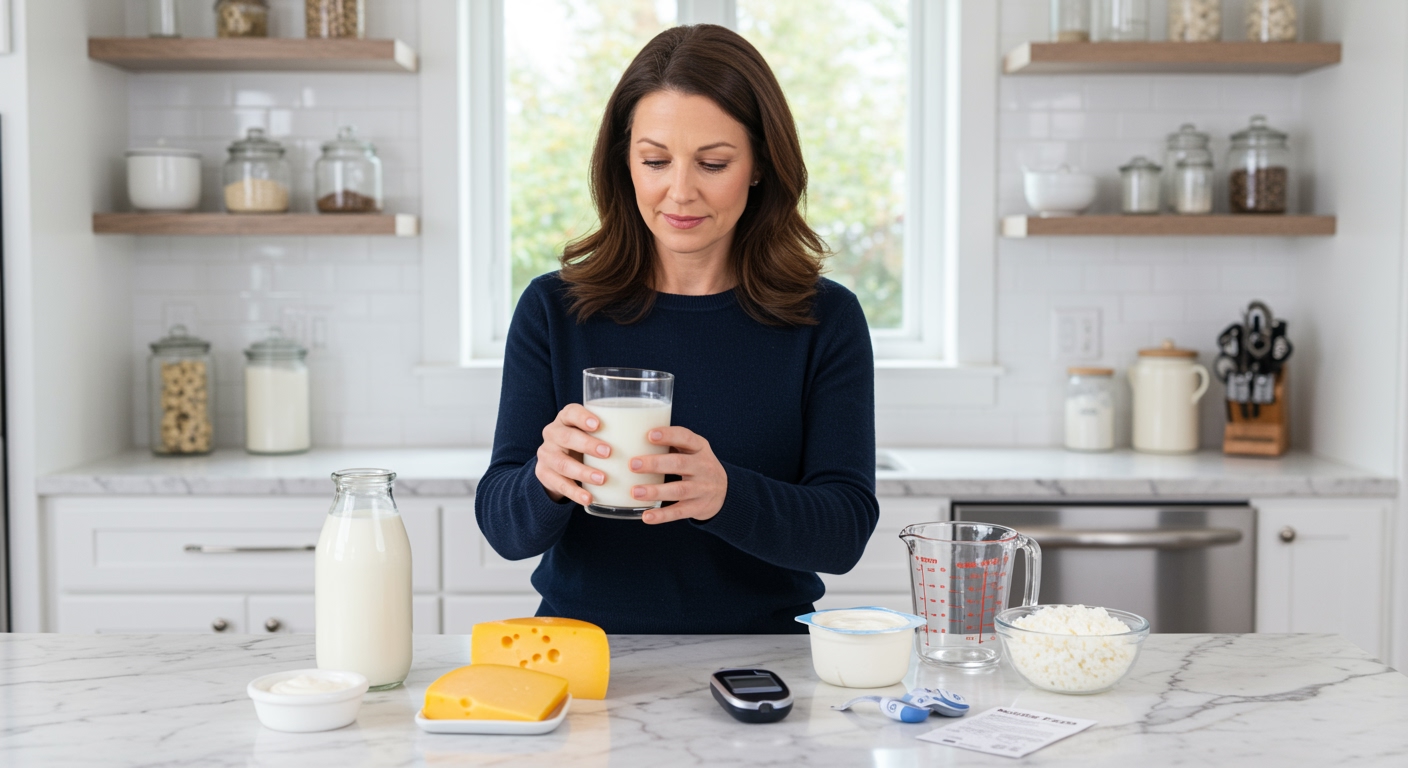✪ Key Takeaway: Milk can be safe for diabetes when consumed in moderation, with low-fat options being better choices than whole milk.
Introduction
You pour yourself a glass of milk and suddenly freeze.
The diabetes diagnosis changed everything about how you view food, and now even this simple white liquid seems dangerous.
Hi, I’m Abdur, your nutrition coach, and today I’m going to explain exactly how milk affects your blood sugar and whether you can safely include it in your diabetes management plan.
Does Milk Raise Blood Sugar Levels?
Milk does raise blood sugar, but not as dramatically as you might think.
One cup of whole milk contains about 12 grams of natural sugar called lactose.
Your body breaks down lactose into glucose and galactose, which enter your bloodstream and cause a moderate rise in blood sugar.
The glycemic index of milk ranges from 15 to 30, depending on the fat content.
This puts milk in the low glycemic category, meaning it causes a slower and more gradual blood sugar increase compared to high-glycemic foods like white bread or candy.
The protein and fat in milk actually help slow down the absorption of lactose, preventing sharp blood sugar spikes.
✪ Fact: Skim milk has a slightly higher glycemic index than whole milk because it lacks the fat that slows sugar absorption.
Which Type Of Milk Is Best For Diabetics?
Not all milk affects your blood sugar the same way.
Low-fat milk and skim milk are generally better choices for people with diabetes because they contain fewer calories and saturated fat.
However, the carbohydrate content remains similar across all dairy milk types at around 12 grams per cup.
Plant-based alternatives like unsweetened almond milk contain only 1-2 grams of carbs per cup, making them excellent options for blood sugar control.
Unsweetened soy milk contains about 4 grams of carbs per cup and provides complete protein, making it another diabetes-friendly choice.
Avoid flavored milks, chocolate milk, and sweetened plant-based milks as these contain added sugars that will spike your blood glucose levels.
Always check the nutrition label and choose products with the lowest carbohydrate content per serving.
✪ Pro Tip: Choose unsweetened plant-based milks to minimize carbohydrate intake while still enjoying the creamy texture you love.
How Much Milk Can Diabetics Drink Daily?
Portion control becomes crucial when you have diabetes.
Most diabetes educators recommend limiting dairy milk to one cup per day or less.
This amount provides beneficial nutrients like calcium, protein, and vitamin D without overwhelming your blood sugar management.
You need to count the 12 grams of carbohydrates from milk as part of your daily carb budget.
If you use milk in coffee, cereal, or cooking throughout the day, these amounts add up quickly.
Consider measuring your milk portions instead of eyeballing them, as most people pour more than they realize.
Some people with diabetes find they can tolerate half a cup of milk better than a full cup, especially when paired with fiber-rich foods.
✪ Note: Track your blood sugar response to different milk portions to find your personal tolerance level.
Can Milk Actually Help With Diabetes Management?
Research suggests milk might offer some unexpected benefits for people with diabetes.
Studies show that consuming low-fat dairy products regularly may reduce the risk of developing type 2 diabetes.
The high-quality protein in milk helps with satiety and weight management, both important factors in diabetes control.
Milk contains bioactive compounds like lactoferrin and immunoglobulins that may have anti-inflammatory effects.
The calcium in milk supports bone health, which becomes increasingly important as diabetes can affect bone density over time.
Some research indicates that the whey protein in milk may help improve insulin sensitivity when consumed as part of a balanced meal.
However, these benefits only apply when milk is consumed in appropriate portions as part of an overall healthy eating pattern.
✪ Fact: Regular consumption of low-fat dairy may reduce diabetes risk by up to 9% according to large-scale studies.
What About Timing And Food Combinations?
When and how you consume milk matters just as much as the amount.
Drinking milk on an empty stomach will cause a faster rise in blood sugar compared to having it with a meal.
Pairing milk with fiber-rich foods like oatmeal or whole grain cereal helps slow down sugar absorption.
The protein in milk works synergistically with other proteins to help stabilize blood glucose levels throughout the day.
Avoid drinking milk late at night, as your body’s insulin sensitivity naturally decreases in the evening.
Morning consumption allows your body to better utilize the natural sugars in milk for energy rather than storage.
If you exercise regularly, consuming milk after workouts can help with muscle recovery without significantly impacting blood sugar when your muscles are primed to absorb glucose.
✪ Pro Tip: Combine milk with nuts or seeds to add healthy fats that further slow sugar absorption.
The Bottom Line
Milk can be part of a diabetes-friendly diet when consumed mindfully and in appropriate portions.
Smart food choices are about balance, not elimination, and understanding how different foods affect your individual blood sugar response empowers you to make better decisions.
I would love to hear about your experiences with milk and diabetes management, so please share your questions or thoughts in the comments below.
References
At NutritionCrown, we use quality and credible sources to ensure our content is accurate and trustworthy. Below are the sources referenced in creating this article:
- Frontiers in Nutrition: Dairy Products and Type 2 Diabetes
- WebMD: What to Know About Diabetes and Milk
- Dairy Nutrition: Milk Products and Type 2 Diabetes
- PMC: Dairy Consumption and Diabetes Risk





